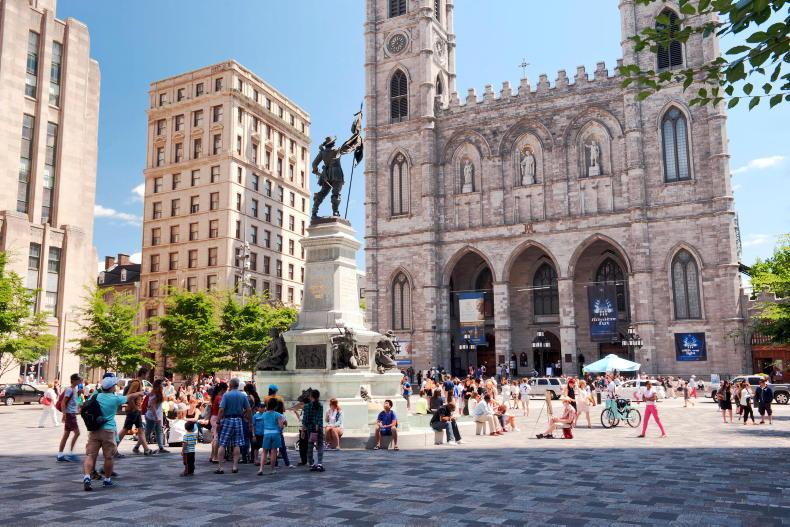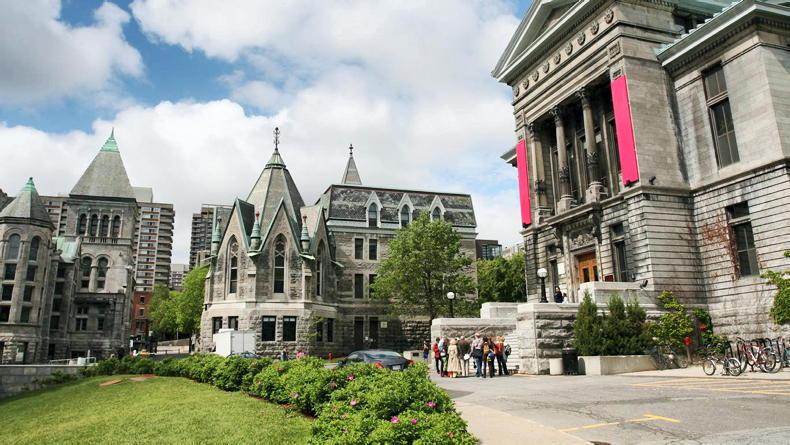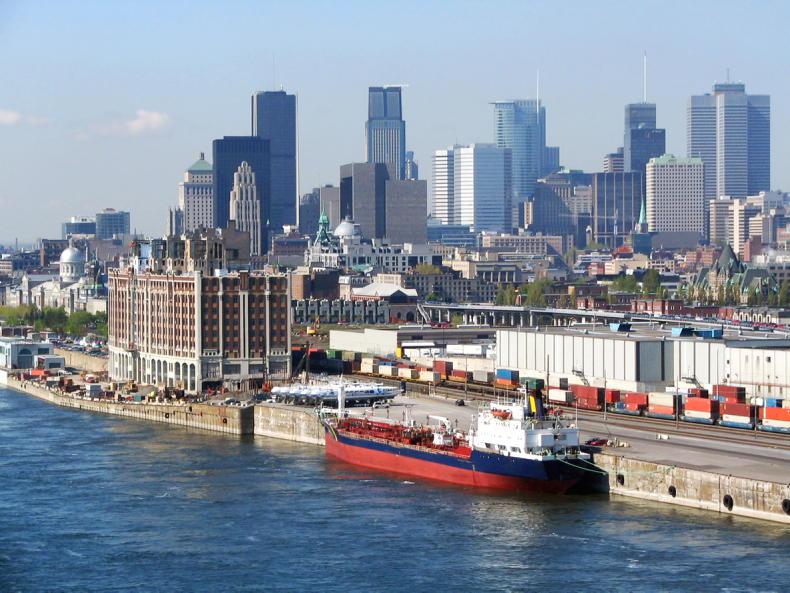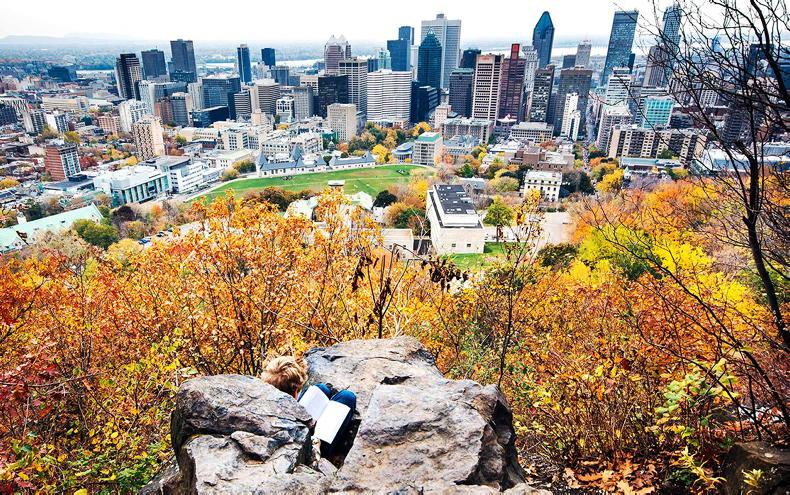Montreal is sometimes referred to as “the Paris of North America”, chiefly, one suspects, by people who have never been to Paris.
Montreal, from Rue de la Montagne to the Old Port, is simply itself, with its poutine, its independent Québécois natives speaking their distinctively sing-song French, its godawful roads that freeze and thaw and crack up anew each year, and the smell of marijuana hanging heavy in the air. It sells itself to tourists as an old European city. The cobbled lanes and neo-gothic churches down by the Old Port are doubtless impressive if you’ve just blown in from Saskatchewan or Nebraska or Texas and have never seen a street with a bend in it before, but for all its charms I never felt Montreal had much affinity with the City of Lights – the waiters were much too friendly, for one thing.
Everyone in Canada is relentlessly friendly, of course. It is what Canadians are known for. The very rare occasions when someone honks their horn at you or you receive less than excellent service in a restaurant come as something of a shock. The staff in our hotel on the Rue Sherbrooke were accustomed to being tipped every time they so much as held a door open for one of their residents, but even after they had learned a few harsh lessons about dealing with the Irish, their warmth and helpfulness scarcely diminished. The majority of the population is francophone, but if your French is as shaky as mine, they will make every effort to speak to you in English, another giveaway that you are not in Paris.
History
Montreal is the fourth largest French-speaking city in the world and a proud bastion of French-Canadian culture. Built on an island in the sprawling St Lawrence River, the origins of the city lie in a fur trading post founded by French explorer Samuel de Champlain in 1611. Missionaries followed, and by 1685 the town, then known as Ville-Marie, was home to some 600 colonists.

Montreal's grandest Catholic church, Basilique Notre-Dame-de-Montreal, in the Place d'Armes. \ Liam Clancy
The modern city takes its name from the steep green hill that dominates the island, Mont-Royal, now a 250 acre park that offers splendid views of the city and a precious escape from urban life for its inhabitants. The French ceded their Canadian territories to Britain in 1763 following their defeat in the Seven Years War. Many of the British merchants and industrialists who subsequently became the chief movers and shakers in Montreal built fine homes on the south-eastern flank of Mont-Royal, in an area that became known as the Golden Square Mile.
Sight-seeing
The latter half of the 20th century saw many of the greystone mansions of the Golden Square Mile demolished and replaced by office blocks and ghastly concrete hotels, but enough 19th century elegance remains along the Rue Sherbrooke and the streets to the north to give one a sense of how Montreal must have been in its heyday as the commercial capital of Canada. We were privileged to have a taste of that opulent Victorian past on our first night in the city, when friends hosted us for a splendid dinner at the Mount Royal Club, formed in 1899 as a private members club for the leading figures in the commercial life of the city.

The Redpath Museum on the McGill University campus. \ Liam Clancy
A little further up Rue Sherbrooke one comes upon the impressive Roddick Gates, the monumental entrance to the McGill University campus. McGill, founded in 1821, is Canada’s best-known university and is internationally renowned for its work in chemistry, medicine, and biology. Of particular interest to the casual visitor is the Redpath Museum, a wonderful 19th century edifice cluttered with taxidermy, fossils, minerals, coins, Egyptian artifacts, African art and much else.
South and east of the Golden Square Mile, the city falls away downhill towards the Saint Lawrence River, through a clean, pleasant downtown area full of preppy students, arresting public art and attractive squares lined with inviting shops and restaurants. Montreal has the highest number of restaurants per capita in Canada, with every taste and budget catered for. Bagels, smoked meat and poutine (dressed fries with notions) are all synonymous with the city.
For visitors wishing to sample authentic local produce, the Atwater Market is well worth seeking out. Housed in a striking 1930s Art Deco building along the Lachine Canal, the market offers cheese, wine, baked goods, meat and of course maple syrup from dozens of vendors. There is a wonderful atmosphere and a very French commitment to the pleasures of the table.

Montreal skyline seen from the St. Lawrence River. \ Liam Clancy
The oldest part of the city meets its bustling international port at Vieux-Montreal. Vieux-Montreal fell into decline in the early 20th century, when the relocation of port facilities further east led to the abandonment of warehouses and commercial buildings, and the rise of the automobile highlighted the shortcomings of its narrow cobblestone streets and little squares. The district underwent a renaissance in the 1980s, and many of its 18th century buildings are now upmarket restaurants and boutiques.
Wildlife
Past the Old Port and around the island of Montreal, oblivious to the waxing and waning of the city’s fortunes, flows the mighty Saint Lawrence River. The Grande rivière de Canada, as it was simply known to early French settlers, was the gateway through which the first European settlers arrived in North America and remains a crucial commercial seaway between the Great Lakes and the North Atlantic Ocean. It is pleasant to turn one’s back on the bustle of Montreal for an hour and watch the cruise boats and the giant mega-freighters that constantly ply the broad river, while skeins of geese stream overhead in the great pale sky.
Besides the ubiquitous Canada geese, the abundant bird life is one of the great draws in this watery region of Canada. I saw my first bald eagle in the Eastern Townships south of the river, and was thrilled to see a pair of ospreys wheeling overhead during a hunt breakfast at Sainte-Andre d’Argenteuil. For those who like their wildlife conveniently near to hand, the Biodôme Environmental Museum is a must-see. The Biodôme, originally built for the 1976 Olympic Games, is an indoor zoo in which visitors can wander through replicas of four ecosystems found in the Americas and interact with the animals who live there. We thought it was wonderful. The sloth in the tropical forest ecosystem has proved such a perennial favourite with visitors that each day the staff leave out a sign with a large arrow pointing to exactly where in the forest canopy he is hanging out.
Unlike the sloth, we had to keep moving. After five days in Montreal we said goodbye to this unique, quirky corner of Canada and headed for Toronto, an hour’s drive west. Leaving Quebec province we crossed into Ontario, and the bizarre French country and western music on the radio gradually fizzled away into static.
Air Canada operates daily direct flights from Dublin to Montreal. We stayed at the 4 star Hotel Omni Mont-Royal. Prices from €228 per night based upon two people sharing.
Montreal is sometimes referred to as “the Paris of North America”, chiefly, one suspects, by people who have never been to Paris.
Montreal, from Rue de la Montagne to the Old Port, is simply itself, with its poutine, its independent Québécois natives speaking their distinctively sing-song French, its godawful roads that freeze and thaw and crack up anew each year, and the smell of marijuana hanging heavy in the air. It sells itself to tourists as an old European city. The cobbled lanes and neo-gothic churches down by the Old Port are doubtless impressive if you’ve just blown in from Saskatchewan or Nebraska or Texas and have never seen a street with a bend in it before, but for all its charms I never felt Montreal had much affinity with the City of Lights – the waiters were much too friendly, for one thing.
Everyone in Canada is relentlessly friendly, of course. It is what Canadians are known for. The very rare occasions when someone honks their horn at you or you receive less than excellent service in a restaurant come as something of a shock. The staff in our hotel on the Rue Sherbrooke were accustomed to being tipped every time they so much as held a door open for one of their residents, but even after they had learned a few harsh lessons about dealing with the Irish, their warmth and helpfulness scarcely diminished. The majority of the population is francophone, but if your French is as shaky as mine, they will make every effort to speak to you in English, another giveaway that you are not in Paris.
History
Montreal is the fourth largest French-speaking city in the world and a proud bastion of French-Canadian culture. Built on an island in the sprawling St Lawrence River, the origins of the city lie in a fur trading post founded by French explorer Samuel de Champlain in 1611. Missionaries followed, and by 1685 the town, then known as Ville-Marie, was home to some 600 colonists.

Montreal's grandest Catholic church, Basilique Notre-Dame-de-Montreal, in the Place d'Armes. \ Liam Clancy
The modern city takes its name from the steep green hill that dominates the island, Mont-Royal, now a 250 acre park that offers splendid views of the city and a precious escape from urban life for its inhabitants. The French ceded their Canadian territories to Britain in 1763 following their defeat in the Seven Years War. Many of the British merchants and industrialists who subsequently became the chief movers and shakers in Montreal built fine homes on the south-eastern flank of Mont-Royal, in an area that became known as the Golden Square Mile.
Sight-seeing
The latter half of the 20th century saw many of the greystone mansions of the Golden Square Mile demolished and replaced by office blocks and ghastly concrete hotels, but enough 19th century elegance remains along the Rue Sherbrooke and the streets to the north to give one a sense of how Montreal must have been in its heyday as the commercial capital of Canada. We were privileged to have a taste of that opulent Victorian past on our first night in the city, when friends hosted us for a splendid dinner at the Mount Royal Club, formed in 1899 as a private members club for the leading figures in the commercial life of the city.

The Redpath Museum on the McGill University campus. \ Liam Clancy
A little further up Rue Sherbrooke one comes upon the impressive Roddick Gates, the monumental entrance to the McGill University campus. McGill, founded in 1821, is Canada’s best-known university and is internationally renowned for its work in chemistry, medicine, and biology. Of particular interest to the casual visitor is the Redpath Museum, a wonderful 19th century edifice cluttered with taxidermy, fossils, minerals, coins, Egyptian artifacts, African art and much else.
South and east of the Golden Square Mile, the city falls away downhill towards the Saint Lawrence River, through a clean, pleasant downtown area full of preppy students, arresting public art and attractive squares lined with inviting shops and restaurants. Montreal has the highest number of restaurants per capita in Canada, with every taste and budget catered for. Bagels, smoked meat and poutine (dressed fries with notions) are all synonymous with the city.
For visitors wishing to sample authentic local produce, the Atwater Market is well worth seeking out. Housed in a striking 1930s Art Deco building along the Lachine Canal, the market offers cheese, wine, baked goods, meat and of course maple syrup from dozens of vendors. There is a wonderful atmosphere and a very French commitment to the pleasures of the table.

Montreal skyline seen from the St. Lawrence River. \ Liam Clancy
The oldest part of the city meets its bustling international port at Vieux-Montreal. Vieux-Montreal fell into decline in the early 20th century, when the relocation of port facilities further east led to the abandonment of warehouses and commercial buildings, and the rise of the automobile highlighted the shortcomings of its narrow cobblestone streets and little squares. The district underwent a renaissance in the 1980s, and many of its 18th century buildings are now upmarket restaurants and boutiques.
Wildlife
Past the Old Port and around the island of Montreal, oblivious to the waxing and waning of the city’s fortunes, flows the mighty Saint Lawrence River. The Grande rivière de Canada, as it was simply known to early French settlers, was the gateway through which the first European settlers arrived in North America and remains a crucial commercial seaway between the Great Lakes and the North Atlantic Ocean. It is pleasant to turn one’s back on the bustle of Montreal for an hour and watch the cruise boats and the giant mega-freighters that constantly ply the broad river, while skeins of geese stream overhead in the great pale sky.
Besides the ubiquitous Canada geese, the abundant bird life is one of the great draws in this watery region of Canada. I saw my first bald eagle in the Eastern Townships south of the river, and was thrilled to see a pair of ospreys wheeling overhead during a hunt breakfast at Sainte-Andre d’Argenteuil. For those who like their wildlife conveniently near to hand, the Biodôme Environmental Museum is a must-see. The Biodôme, originally built for the 1976 Olympic Games, is an indoor zoo in which visitors can wander through replicas of four ecosystems found in the Americas and interact with the animals who live there. We thought it was wonderful. The sloth in the tropical forest ecosystem has proved such a perennial favourite with visitors that each day the staff leave out a sign with a large arrow pointing to exactly where in the forest canopy he is hanging out.
Unlike the sloth, we had to keep moving. After five days in Montreal we said goodbye to this unique, quirky corner of Canada and headed for Toronto, an hour’s drive west. Leaving Quebec province we crossed into Ontario, and the bizarre French country and western music on the radio gradually fizzled away into static.
Air Canada operates daily direct flights from Dublin to Montreal. We stayed at the 4 star Hotel Omni Mont-Royal. Prices from €228 per night based upon two people sharing.









 This is a subscriber-only article
This is a subscriber-only article





SHARING OPTIONS: